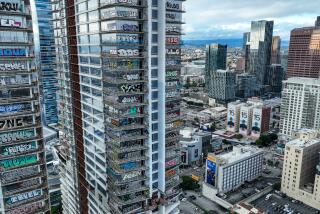Los Angeles Six Months After: The Determination of a City
Itâs an uphill fight, but Los Angeles is making progress after the worst urban riots in this nationâs history.
In fits and starts, in heroic bursts and disappointing fizzles, the riot zones are starting to come back. Although itâs true that our city will never be quite the same, it can become a better place for everyone if we all never let up, if we all never let hope die.
THE RIOTSâ AFTERMATH: In last weekâs four-part series âUnderstanding the Riots--Six Months Later,â The Times reported on some of the victories and defeats. Reporters also explored the larger questions of race, ethnicity and class that continue to haunt a city that is multicultural but divided, and in no way colorblind.
Sadly, all is not well. The psychological wounds have not healed completely. The walls that separate African-Americans, Latinos, Asian- Americans and whites have, in some instances, grown even higher. These self-erected fences make even more poignant Rodney G. Kingâs simple but eloquent question: âCanât we all get along?â
The riots brought to the surface lingering hostilities between blacks and Korean-Americans. The devastating loss of jobs exacerbated competition for paychecks among all the cityâs poor, especially Latinos.
After the fires, whites who had traveled easily throughout most areas warily mapped their routes to avoid the infamous intersection, Florence and Normandie--the flash point of the rage--and many other parts of inner-city Los Angeles.
The competition for affordable housing has turned historically black South-Central Los Angeles into a demographic checkerboard of competing neighborhoods.
New neighbors can break down racial barriers--but not when the newcomer is seen as a rival. Co-workers can get to know each other--but not when the new guy is a threat.
The Los Angeles Police Department, under the leadership of the new chief, Willie L. Williams, is expected to become decidedly friendlier as the practice of community policing takes hold.
Any improvement will come as a relief to citizens who decried the videotaped police beating of King, the not guilty verdicts in the trial of the officers involved and the absence of an aggressive blue line that should have acted quickly to contain the violence when the first fires burned.
THE WILLIAMS PLUS: The police will become more visible and more effective if the chief can find the money and/or the methodology to put more cops on street patrol. That is the plan, but so far the strapped city has provided only a mere down payment on what the LAPD really needs in order to do a good job of protecting and serving.
Without more money, Williams must constantly shift and juggle to preserve a new covenant between community and police--a mandatory effort in the wake of the beating of King and all that followed.
More police--who are better trained, better managed and better disciplined--are certainly a principal part of the solution. After all, the riots started--like most urban conflagrations in the past--in response to a perceived law enforcement injustice. If, in the wake of the riots, the cops can make neighborhoods now filled with crime much safer, more new businesses will consider bringing in more jobs.
THE JOBS FACTOR: Jobs--new jobs, more jobs, better-paying jobs--are seen by some as the general remedy for just about everything that ails the inner city. Though a single prescription is not the whole cure, good jobs are obviously central to any renaissance, human and physical.
Much of the hope for job creation--perhaps too much--has been pinned on Rebuild L.A., the civic/community coalition formed by Mayor Tom Bradley to coordinate the renewal even before the last cinder had cooled. After a seemingly slow start, RLA has moved to attract businesses willing to invest in the inner city. Some unfortunate overstatement of its accomplishments aside, RLA remains a crucial vehicle for long-term economic solutions for the area.
THE RLA LIMITATION: By definition, RLA must take the lead in local job creation. But it canât move alone. Other institutions and organizations should press ahead with their own ideas and commitments. Help must also come from the federal government and determined individuals willing to use their brains, spunk and persistence to develop an economic stake close to home.
Small businesses need money to grow. To nurture that significant type of job creation, lenders must be pressured to stop redlining and to figure out how to do more despite more stringent capital requirements.
Insurance firms also must stop redlining. With the prodding of state Insurance Commissioner John Garamendi, the guarantors of last resort also must participate more fully, and at reasonable rates, in neighborhoods too often shunned by insurers.
The social redlining must end as well if Los Angeles is to become multicultural in the most positive sense. We have all been touched by the flames. From the ashes, Los Angeles must craft a productive, inclusive and healing legacy for the future. And it will. Let no one underestimate the cityâs determination.
More to Read
Sign up for Essential California
The most important California stories and recommendations in your inbox every morning.
You may occasionally receive promotional content from the Los Angeles Times.










